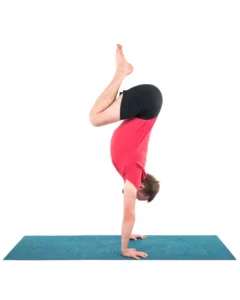Chronic Pain: How Yoga Teachers Can Help

Article At A Glance
A recent study found that there are more new cases of chronic pain among U.S. adults than other chronic health problems like diabetes, depression, or high blood pressure. The study reported that 20 percent of U.S. adults are dealing with chronic pain. A couple of things: if you love teaching slower, more mindful versions of yoga practice, that’s good because it’s the kind of yoga that can help people begin to unravel their chronic pain. It’s the kind of yoga that the world needs right now.
While I love fitness and exercise, yoga is different for me. Yoga is my refuge. Even 20 years ago, when intense yoga totally dominated the landscape, and I was clueless about explaining how what I taught was useful and not some kind of watered-down version of “real” yoga, I just couldn’t bring myself to join the sweat fest.
I started my yoga teaching career in an assisted living facility, working with residents with various disease processes. I also taught regular mat classes, primarily attended by the wisest element of every culture—middle-aged and older women. And while I’ve gone deep into yoga therapeutics and feel comfortable in that realm, yoga for preventing disease and promoting health is what really excites me.

As the population ages and we see upticks in chronic health conditions, we will need an increasing number of well-trained yoga teachers and therapists to cross the bridge from fitness to wellness and therapeutics.
Chronic Pain: How Yoga Can Help

As Dr. Timothy McCall said, “When word gets out about how powerful these practices are, there will not be enough well-trained teachers to meet the demand.” (I’ve often remembered that quote over the years when things felt bleak in the yoga space).
There’s a good chance that some of your students are dealing with chronic pain.
Recently, a study found that there are more new cases of chronic pain among U.S. adults than other chronic health problems like diabetes, depression, or high blood pressure. The study reported that 20 percent of U.S. adults are dealing with chronic (or what I prefer to call “persistent” pain).
A couple of things: if you love teaching slower, more mindful versions of yoga practice, that’s good because it’s the kind of yoga that can help people begin to unravel their chronic pain. It’s the kind of yoga that the world needs right now. And (as I hear myself repeat ad nauseam but feel morally obligated to do so), yoga doesn’t fix everything, but it can be a very useful piece of the puzzle.
A Quick Primer on Chronic Pain for Yoga Teachers
Yoga teachers can begin by educating themselves about chronic/persistent pain. Here are a few tips:
- Persistent pain is not the same thing as acute pain. Acute pain is typically the result of a problem—injury, or a medical issue like a kidney stone. It’s tissue damage. But persistent pain is not the result of a problem. Persistent pain IS the problem. This is the first step in understanding that there are different kinds of pain. It’s such a hard shift to make that many in the medical community still struggle with it. If we are to find lasting solutions to the chronic pain crisis—and the opioid epidemic it has spawned—we must rewire our neural networks that equate pain with injury and start to see things differently.
- Persistent pain is pain that lasts more than 3 to 6 months.
- Persistent pain is also called “Brain Pain” or “Central Sensitization.” The brain has learned to be sensitive; it has learned to be in pain. It loses its capacity to process sensations appropriately.
- There are no pain-signaling receptors. We have danger receptors. These are called Nociceptors. Nociceptors come in a few varieties including some that sense temperature, movement, and chemicals. Nociceptors are looking out for danger, not pain. Also, you don’t have a specific “pain center” in your brain. A complex interaction of different areas of the brain perceives pain. Many psychological and social factors also influence it. Do you feel safe, loved, cared for, supported, resourced? Answers to these questions contribute to whether or not you feel pain.

- To begin to unravel the wiring of persistent pain, the body needs to feel safe. Movement needs to feel safe, interesting, and even fun. Adopting an attitude of curiosity about your body and movement can go a long way toward reducing feelings of fear that perpetuate the cycle of pain.
- Chronic pain is a public health issue. It is as cultural as it is biological. People seek out solutions to their pain via medication, and this has led to an epidemic. COVID-19 increased suicides and deaths by overdose by a stunning 20 percent. Chronic pain is not just an individual problem; it is a reflection of deep dysfunction in the culture.
- Research suggests that people who deal with persistent pain and receive Chronic Pain Education and treatment show better outcomes.
How Yoga Teachers Can Help
Yoga teachers can be supportive allies in taming this cultural crisis. You can teach your students about persistent pain and point them to resources. Yoga can be a part of the solution to chronic pain. The more yoga teachers who understand chronic pain interface with health care professionals, the more we can utilize our skills to support those suffering.
Also, read...
Wrist Pain During Yoga? 4 Tricks to Eliminate Discomfort
May 07 – By: Meagan McCrary
Yoga for Neck Health: Exploring Brahma Mudra
Apr 28 – Baxter Bell, MD, eRYT 500, C-IAYT
Carpal Tunnel Syndrome: A Yoga Sequence to Soothe Sore Wrists
Apr 03 – Kathryn Boland, R-CYT, R-DMT
Related courses
Breath as Medicine: Yogic Breathing for Vital Aging
With Doug Keller
Yoga and Myofascial Release: Releasing Chronic Tension with the Bodymind Ballwork Method
With Ellen Saltonstall
Yoga and Detoxification: Tips for Stimulating Lymphatic Health
With Lisa Levitt Gainsley
Reprinted with permission from SubtleYoga.com

 Committed to the widespread adoption of yoga as a population health strategy, Kristine Kaoverii Weber, MA, C-IAYT, eRYT500, YACEP has been studying yoga and holistic healing for nearly 30 years advocating, speaking, and teaching about yoga since 1995, and training educators since 2003. Her organization, Subtle® Health, LLC, provides holistic, mind-body training, education, and clinical services with the mission of enhancing community health infrastructure. She is the director of the Subtle® Yoga Teacher Training for Behavioral Health Professionals program at MAHEC in Asheville, NC, presents workshops and trainings internationally, and is frequently invited to speak about yoga at health care conferences. After completing her BA and MA at Georgetown University, Kristine trained extensively in many styles of yoga, including Viniyoga, as well as in Asian bodywork therapy and homeopathy.
Committed to the widespread adoption of yoga as a population health strategy, Kristine Kaoverii Weber, MA, C-IAYT, eRYT500, YACEP has been studying yoga and holistic healing for nearly 30 years advocating, speaking, and teaching about yoga since 1995, and training educators since 2003. Her organization, Subtle® Health, LLC, provides holistic, mind-body training, education, and clinical services with the mission of enhancing community health infrastructure. She is the director of the Subtle® Yoga Teacher Training for Behavioral Health Professionals program at MAHEC in Asheville, NC, presents workshops and trainings internationally, and is frequently invited to speak about yoga at health care conferences. After completing her BA and MA at Georgetown University, Kristine trained extensively in many styles of yoga, including Viniyoga, as well as in Asian bodywork therapy and homeopathy.
She is the author of The Complete Self Massage Workbook and has published articles in the International Association of Yoga Therapist’s journal, Yoga Therapy in Practice, and other wellness publications. Her work has been featured in Redbook, BodySense, Women’s World, Natural Health, and Lifetime TV.
Recent articles
Fascia and the Vagus Nerve: Healing from the Inside Out
Jul 10 – Dr. Arielle Schwartz
Change Your Perspective of Pelvic Tilting: How the Transversus Abdominis Can Help
Jul 08 – Olga Kabel C-IAYT
Warrior I Pose: 5 Strengthening Variations
Jul 02 – Bridget Frederick, eRYT 500
Categories
Upcoming courses
Breath as Medicine: Yogic Breathing for Vital Aging
With Doug Keller
Yoga and Myofascial Release: Releasing Chronic Tension with the Bodymind Ballwork Method
With Ellen Saltonstall
JOIN NOW!
Recent articles
Almost there...
Sorry, we couldn't find anything...
Stress Relief
Fascia and the Vagus Nerve: Healing from the Inside Out
Have you ever had a morning in which you woke up with a painful…
Jul 10 – Dr. Arielle Schwartz
Pose Library
Change Your Perspective of Pelvic Tilting: How the Transversus Abdominis Can Help
“Tuck your tailbone under” or “lengthen your tailbone” have long been among the most…
Jul 08 – Olga Kabel C-IAYT
Yoga Practice Tips
Warrior I Pose: 5 Strengthening Variations
Warrior I Pose (Virabhadrasana I) is an excellent pose for strengthening your whole back…
Jul 02 – Bridget Frederick, eRYT 500




